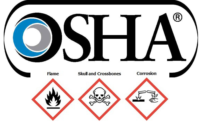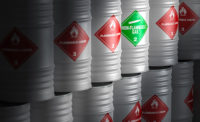Information about hazardous chemicals in the workplace, their potential hazards and the appropriate precautions must be communicated by an employer to all workers, including other employer's personnel and outside contractors who share the work site. This can be a key issue in the construction business.
The written program documents how you identify hazardous chemicals, how employees are made aware of these hazards, necessary precautions, and the location and use of material safety data sheets (MSDSs).
Minimum information for labeling hazardous chemicals consists of the identity of the chemical; appropriate physical hazard and/or health hazard warning in words or pictures; and who to contact in an emergency. Remember, the name of the chemical also must be provided, and if it's a health hazard, the target organ must be listed.
An inventory list must include all hazardous chemicals used at the work site. Chemicals should be listed by the name that appears on the MSDS and the label. This list can ensure that the MSDS for each hazardous chemical has been received and properly filed.
A written program also addresses other hazards -- describing how employees will be informed about hazardous chemicals involved in non-routine tasks such as infrequently performed operations, spills and emergencies, and chemicals in unlabeled pipes.
MSDSs are especially valuable when used by supervisors and others in pre-job planning to determine what precautions or controls are needed for working with a hazardous chemical. MSDSs may also be used by emergency medical personnel responding to a chemical overexposure or an accident.
Training is mandatory before working with hazardous chemicals and when the process or the types or hazardous chemicals change. Retraining is recommended as needed, but not required.
Overall, the standard applies to employees who may be "exposed" to a "hazardous chemical." "Exposed" means the potential to inhale, ingest, or come into skin contact (including splashes) during the course of routine operations, non-routine tasks, or in an emergency. A "hazardous chemical" has the characteristic of a physical and/or health hazard. Chemicals with physical hazards can be flammable; combustible; a compressed gas; explosive; or dangerously reactive with air, water or other materials. Health hazards are more difficult to observe and are scientifically shown to produce chronic (long-term, low-level) or acute (short-term, intense) effects.
Communication is key
So how are these requirements carried out on a construction site, where there are often multiple employers? Both the contractor employer and the host-site employer have responsibilities for sharing their hazard communication programs and training with each other. Understanding what is expected from each party is important. Here are several guidelines:1. The host employer must maintain a program with the six elements, and share the program with contractor employees or any other employers on site.
2. Contractor employers who bring in or use hazardous chemicals that others may be exposed to also have responsibilities. Their program must describe how hazards are communicated to other employers on site, including methods for providing MSDSs, informing others of precautions/personal protective equipment, and informing others of their labeling system.
3. It's OSHA's position that training can be provided by others besides the current employer, including past employers and employee unions. But the current employer is responsible for assuring that employees are adequately trained, regardless of who did the training.
4. When a new employee is hired who has previously been trained by someone else, be sure to evaluate that person's level of knowledge. And no matter how good the training from someone else was, site-specific information should be covered, such as the location of the written program and the MSDS file.
5. Often contractor employees are assigned to jobs working directly under the supervision of another employer. In this case, generic training should be provided on hazard recognition, precautions, labels and MSDSs as a minimum. Then the contractor employer can provide training specific to the hazardous material at the job site.
Remember, the host employer is still responsible, so when relying on another employer be sure that their training is done to your satisfaction.

